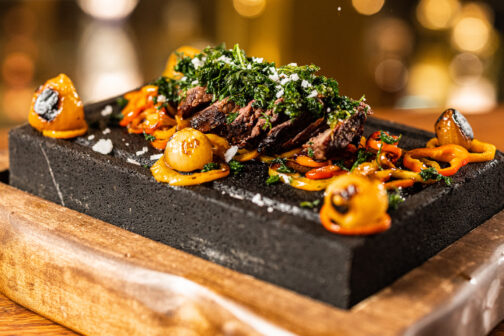The new Reunion Tower restaurant doesn’t revolve. You won’t be able to sit at your table at Crown Block and slowly watch the Dallas skyline unfold below. Much of the early press for the restaurant focused on the reasons for keeping still, particularly the fact that the view at the entryway and bar will now be fixed, providing maximum wow factor when guests step off the elevator.
But there are more practical reasons for motionlessness. The machinery that drove the dining floor’s movement occupied valuable space that can now be used to prepare food. The rotating floor complicated matters like plumbing and lighting. Diners no longer need to worry about motion sickness.
And then there was the mangled leg. In 2016, an employee of Five Sixty by Wolfgang Puck, the previous tenant, became entangled in underfloor machinery while it was still moving. That accident was not a factor in the decision for newcomer Crown Block to be stationary; its management team didn’t know about the injury until D Magazine asked for comment for this story. But as Dallasites debate whether or not Reunion Tower’s restaurant should spin, they should know that the choice has safety implications.
Previously unreported court records show that the incident took place April 5, 2016, and the former employee sued Hunt Realty Investments and Reunion Hotel, LP in 2018. The lawsuit describes the injury in minimal detail: “One of the tenant’s employees was required to use the access panel in an attempt to retrieve an item which had fallen through the floor and landed on the sub-floor. While doing so, the employee’s leg became trapped in the equipment, and he sustained a severe injury.” According to the lawsuit, the access panel used by the victim did not have an automatic safety device to stop the floor’s rotation when the panel was opened.
Another former employee who witnessed the accident told D Magazine that it began when a customer’s credit card slipped through a crack between the revolving floor and a stationary wall during dinner service. The witness said the victim attempted to retrieve the credit card, but the floor continued to rotate, slowly gouging into the victim’s calf muscle and crushing the person’s leg while other employees scrambled to find an emergency stop button. Details of the witness’s account were corroborated by the lawsuit and another source with knowledge of the incident.
Court records show that the case was settled in July 2019. A representative for the victim’s law firm said that the settlement terms are confidential and declined comment on the client’s behalf, saying that the person did not want to revisit memories of the incident. The Five Sixty dining room continued to rotate until its closure in 2020.
Hunt Realty Investments offered this statement: “The vision for the new restaurant was thoughtfully vetted to create an exciting new aesthetic and dining experience for customers. We have no further comment on the matter.”
The first restaurant to rotate inside the Reunion Tower was Antares, which opened in 1978 and closed in 2007 as part of a $55 million renovation for the tower and Union Station. It’s unknown if there were any safety incidents while Antares was operating.
While the Crown Block team didn’t know about the accident at Five Sixty, rotating restaurants have a history of causing injury. At Houston’s Spindletop, a 4-year-old girl got her foot caught in the crack between the floor and wall, and her parents later claimed that employees were unable to stop the rotation. The girl sustained lacerations. In Atlanta, a 5-year-old child died when his head got stuck between a rotating floor and non-rotating wall. A 1977 academic pediatrics paper discussed a child in Tampa who became “compressed” between a booth and wall and suffered blunt chest trauma.
Now that Five Sixty and Spindletop are closed, the Houston Chronicle reports that only 17 revolving restaurants remain in the United States. The last one in Texas is in San Antonio, but before you plan a trip, be aware of its own alarming quirk: a history of at least 15 incidents of visitors getting trapped in the tower’s elevators.
Author







